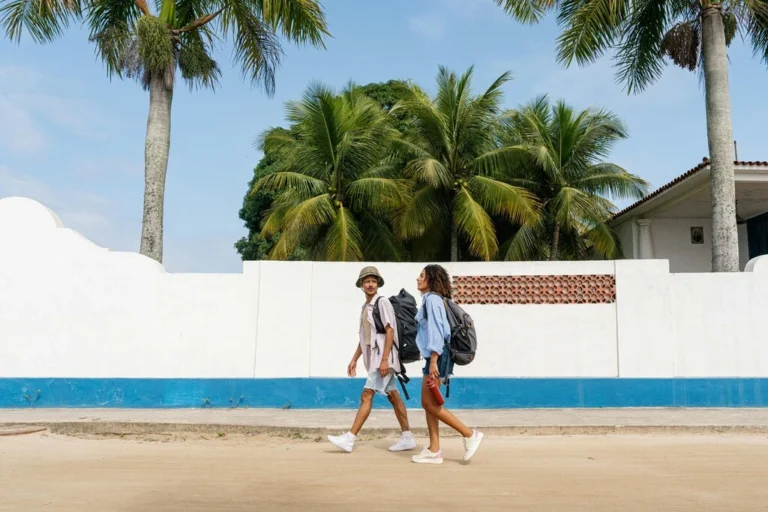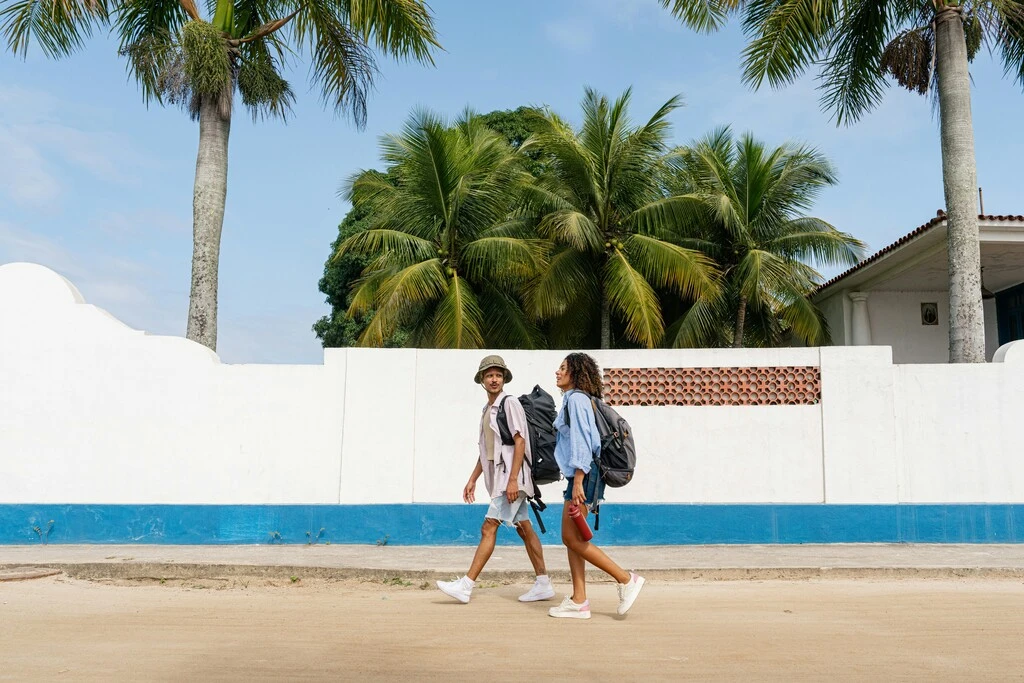Updated in January 2025!
We’ve been living in Thailand since 2019, and we often get asked if we are eating out with kids here frequently. The answer is simple: Yes, and almost exclusively. We only have a small Thai kitchen at home, and the food outside is just too good to resist.
Dining out with young children, especially picky eaters like ours, in Thailand can be tricky. On top of that, we’re vegetarians. But there are plenty of tips and tricks that you can use to make eating out with kids in Thailand stress-free and enjoyable for everyone.
In this guide, you’ll learn what to watch out for when eating out at local eateries, street food stalls, and international restaurants, which Thai dishes are best suited for kids, and what local etiquette you should be mindful of.
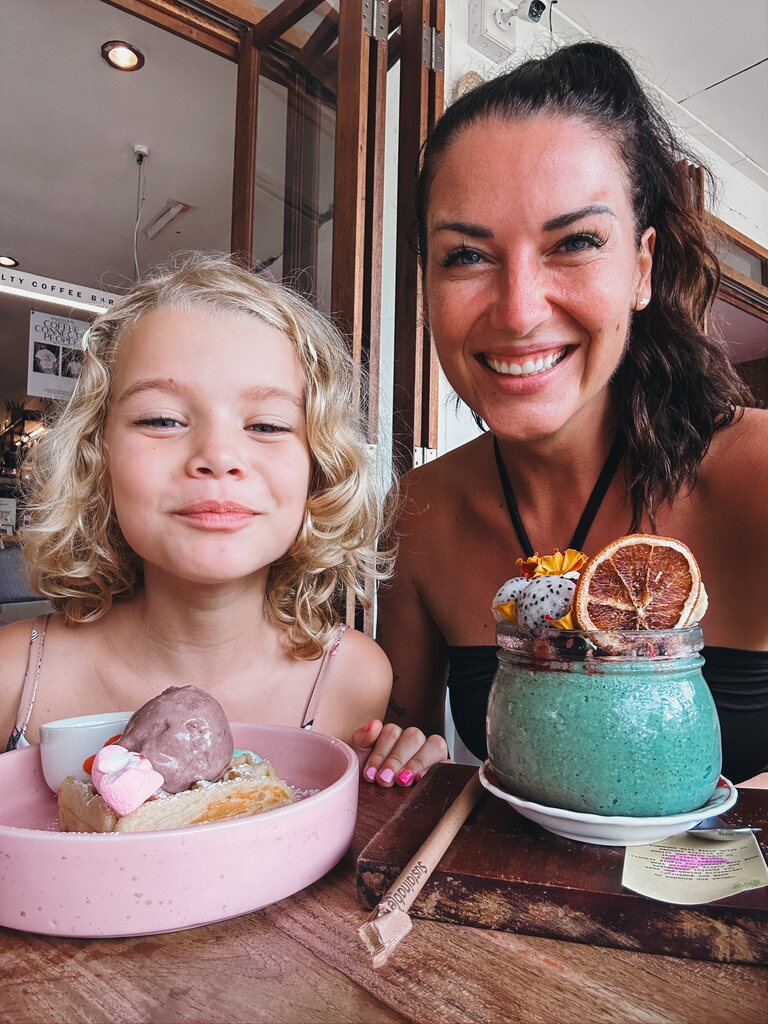
Types of Kid-Friendly Restaurants in Thailand
Local Eateries and Street Food Stalls
In Thailand, you’ll find small street stands and local eateries with plastic chairs along the road everywhere. You’ll also find these types of food stalls at large night markets. They primarily offer Thai cuisine, like fried snacks and local noodle or rice dishes.
The advantage: Nowhere else will you find such delicious food in Thailand at such a low price. Plus, it’s a very authentic experience since this is how most locals eat.
💡 Tip: Try to find stalls that cook fresh for you and don’t have pre-made dishes. This way, you can directly communicate what you want, or rather, what you don’t want in your dish.
Look for stalls that generally appear clean, where fresh ingredients are visible, and where lots of people are eating (the crowd indicator never lies!).
Also, if you choose stalls that aren’t directly on busy roads, you’ll avoid getting dust and pollution in your food.
Common kid-approved dishes:
- Pad Thai
- Mango Sticky Rice
- Fried Rice with Egg
- Noodle Soups
- Thai Ice Cream (frozen sweet drinks, served as pop stickles from street vendors on markets and food courts)
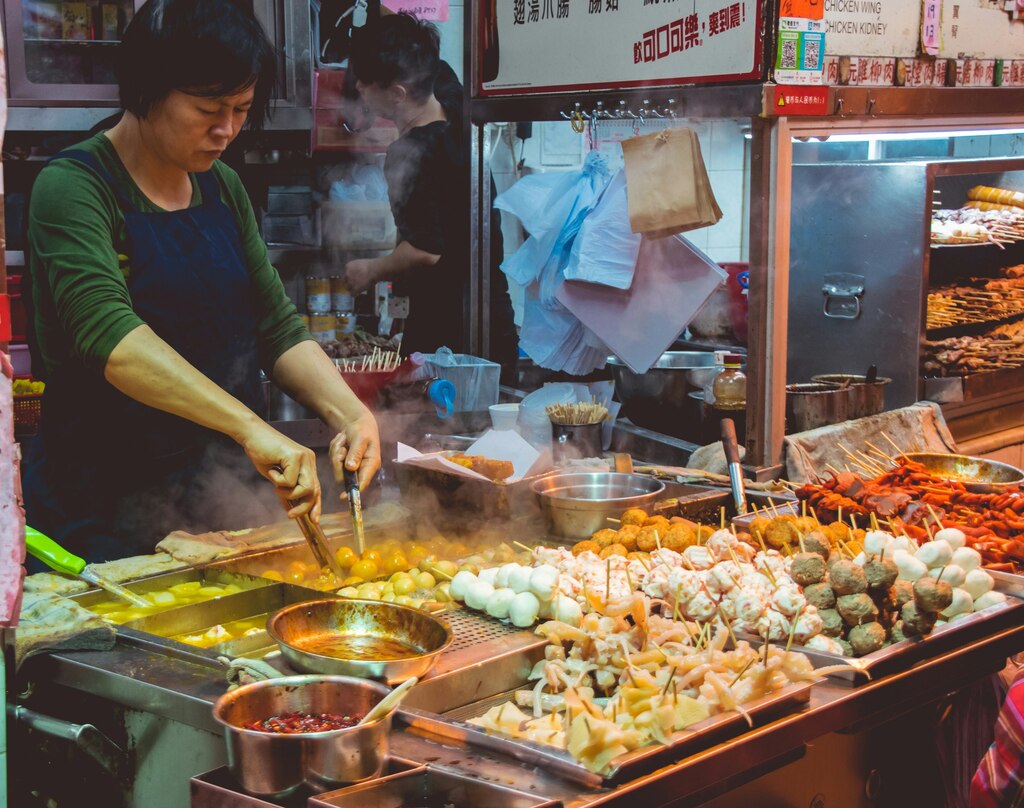
Casual Restaurants and Cafés
There are plenty of family-friendly cafés and casual restaurants in Thailand. Some even have play areas and special kids’ menus. If you’re in a tourist area like Chiang Mai or Koh Samui, you’ll easily find places catering to families.
You usually have a safer environment or even indoor seating with AC. The mere fact that the kids can’t run out onto the street is sometimes worth its weight in gold.
💡 Tip: Try to find restaurants that have high chairs to make your experience more relaxed. But be prepared that many won’t have high chairs. This means you might have to get a bit creative. Either let the child sit in the stroller next to you, on your lap, or elevate the normal seat with a few cushions.
Common kid-approved dishes:
- Pad Thai
- Mango Sticky Rice
- Fried Rice with Egg
- Spring Rolls
- Noodle Soup
International Restaurants
Some days, the kids just want fries, and I just want pizza. So, we hit up the international restaurants because, let’s face it, sometimes you just need a break from rice. Eating out with kids in Thailand doesn’t always mean Thai food—and that’s okay.
Tips: It’s important not to spoil your kids with Western restaurants when you stay longer in Thailand. Otherwise, they might eventually turn their noses up at Thai food. We’ve been there.
Common kid-approved dishes: Anything from pasta to French fries, pizza, and the like.
Where to Stay in Bangkok
Check out these amazing hotels in Bangkok, or use the map below. 👇
Fine Dining
Especially in big cities like Bangkok or tourist destinations like Phuket or Koh Samui, there are also excellent fine dining options. My husband and I love fine dining in Thailand because the quality is very high, but the prices are quite low.
Fine dining with kids is, of course, always a bit tricky. I generally recommend finding a nanny who can look after your little ones for a couple of hours so you can enjoy this special experience undisturbed.
But if you want to take the kids with you, you should discuss with the restaurant beforehand if that’s possible and if they can provide child-friendly meals. Also, check if they have high chairs and whether you can get a table a little off to the side where you won’t disturb other guests as much.
💡 Tips: For us, it’s always been helpful to choose a time for the set menu that’s not so common, like dinner at 6 pm. Most fine dining restaurants are still pretty empty then, so you are sure of a relaxed atmosphere and don’t have to worry so much about other guests. Some even offer a private dining room.
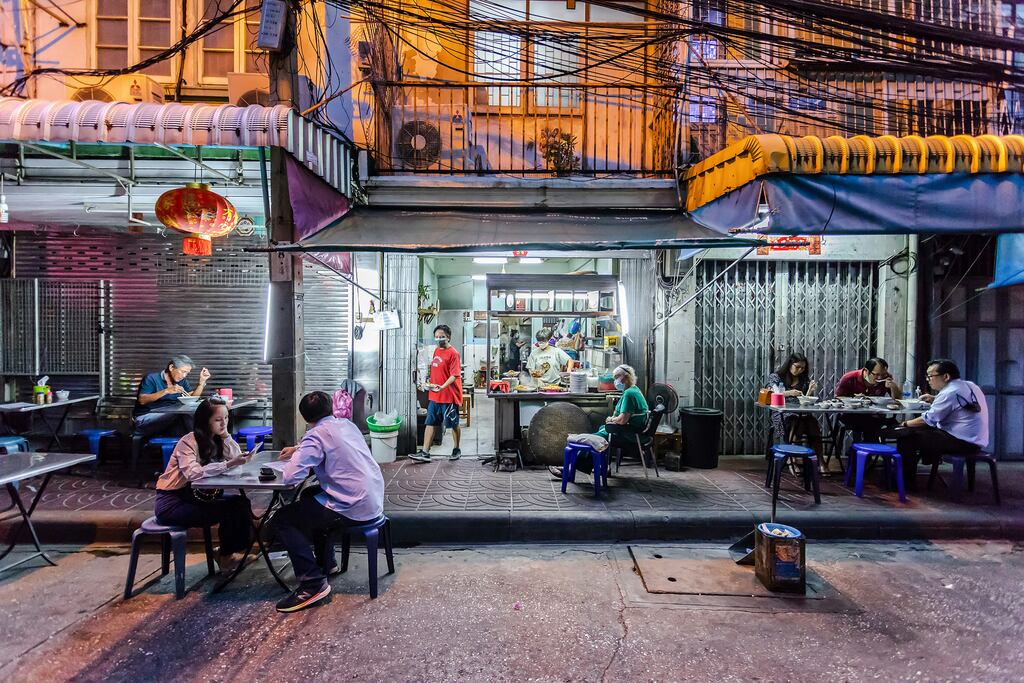
What to Expect: Cultural Etiquette and Customs
Dining in Thailand is a relaxed experience, perfect for families with young children. Sharing plates is common, so everyone gets to try a bit of everything.
Sometimes, you sit on the floor on cushions at low tables, which makes eating with kids much easier.
Thai people are incredibly polite and patient, so don’t worry if your little ones take their time or make a big mess.
We’ve actually experienced many times when we were at a restaurant that the Thai staff completely took care of our children. One would carry the baby around while another played cards with our older one. It’s really heartwarming to see how much Thais love and care for children.
One thing you should be prepared for is that dishes almost never arrive at the same time. So, it’s not worth waiting for everyone else if your food is already on the table. Chances are, their dishes might arrive just when yours has gone cold.
At first, we found it a bit frustrating, but now we’re totally relaxed about it and just eat in shifts. You have to be flexible and don’t expect Western behavior.
Water and Beverage Safety in Thailand
When eating out in Thailand, it’s really important to stick to bottled water. Tap water isn’t safe to drink, but most ice cubes nowadays are made from filtered water, so they’re generally safe to order.
To keep things simple and worry-free, just go for bottled water or soda water, or try a refreshing drink like coconut water. Coconut water is available everywhere, and kids love it! Plus, it’s packed with electrolytes, making it a great way to stay hydrated in the heat.
Dealing with Bugs
When you’re eating outside in Thailand, especially at street food stalls or on the beach, watch out for mosquitoes. They can be so annoying. I always bring insect repellent with me, just to be safe. If you prefer something natural, citronella works great, too. It’s a simple way to keep the bugs away and enjoy your meal without worrying about bites.
I like to call sunset time between 5:30 and 6:30 pm the “mosquito happy hour” because that’s when they come out in full force, ready to feast. Better be prepared!
Emergency Numbers or Health Precautions
It’s always good to be prepared, just in case. If anyone in your family feels unwell after eating, it’s smart to have the number of a local doctor handy or know where the nearest pharmacy is.
Most pharmacies in Thailand are really helpful, and many of the staff speak some English. They can usually recommend something if you’re dealing with a mild issue. We rarely visit a doctor or hospital here because the pharmacies are so well-trained, and many medications, even antibiotics, are available over the counter.
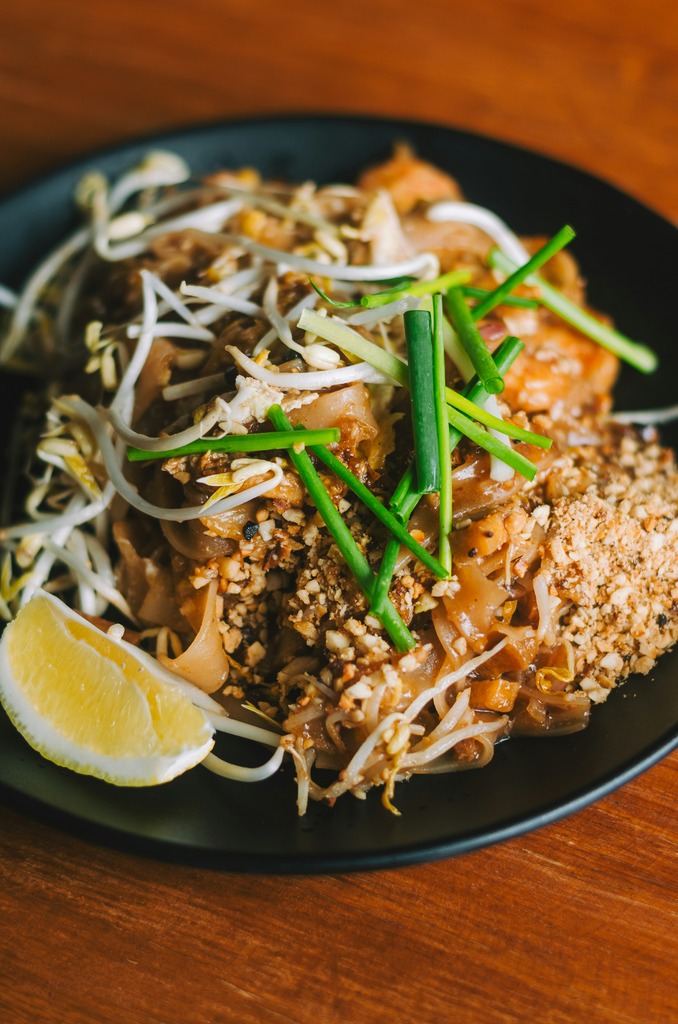
Tips for a Stress-Free Dining Experience
Preparation is Key
We always look at the menu beforehand. This is because we’re vegetarians. But in the process, you can also check if there’s enough variety for kids on the menu.
Bring along essentials that you know will be useful for your child. Things like a bib with a catch pocket, toys, wet wipes, and emergency snacks in case the hunger hits much earlier.
For toddlers and older kids, we also always have an iPad with two pairs of AirPods with us. Sometimes, the service is really slow, and patience runs thin. Then our last resort is to watch cartoons until the food arrives.
I think that’s totally fine in moderation. Here in Thailand, no one will judge you for it either. On the contrary, it’s more unusual if you don’t have electronic devices with you.
Time It Right
We’ve had it happen so often that we were perfectly prepared—we had everything with us, the restaurant had enough kid-friendly options on the menu—but we just went at the wrong time. The worst is when hunger is already too intense, and everyone’s mood has already turned. When you’re hangry, no one has the patience or desire to try something new. Or when it’s already too late, and the child is in a bad mood because of tiredness.
So, try to time the meal right. Early dinners also help you avoid the crowds. If you eat outside of peak hours, it’s quieter and more relaxed.

Handling Picky Eaters & Lack of Kids’ Menus
Here’s the thing about eating out with kids in Thailand: There aren’t many ‘kids’ menus.’ But honestly, who needs one when you can tweak any dish? Fried rice with just egg? Done. Mango sticky rice on repeat? Go for it. The kids don’t care, and neither do I.
Most restaurants in Thailand work with fresh ingredients and cook from scratch. This means that if communication allows, you can put together a kid-friendly dish yourself.
It gets tricky with dishes like curries, where curry paste is used, which already contains things like oyster sauce and shrimp paste. But spicy food like Thai curries aren’t suitable for kids anyway, so it doesn’t matter.
While our youngest daughter eats everything we put in front of her, our older daughter is extremely picky. She won’t even eat fried rice with vegetables. It has to be fried rice with egg only. To make sure she still eats at least a bit of healthy food, we have the following deal: She can eat fried rice with egg, but there’s also a plate of freshly cut carrots and cucumber.
This works great and usually costs only a few Thai Baht extra. Sometimes, Thai restaurants even have fruit plates or veggie plates on the menu.
When it comes to hotels, I strongly suggest choosing one that offers buffet breakfasts. It’s by far the easiest way to ensure a stress-free breakfast in Thailand with a picky eater.
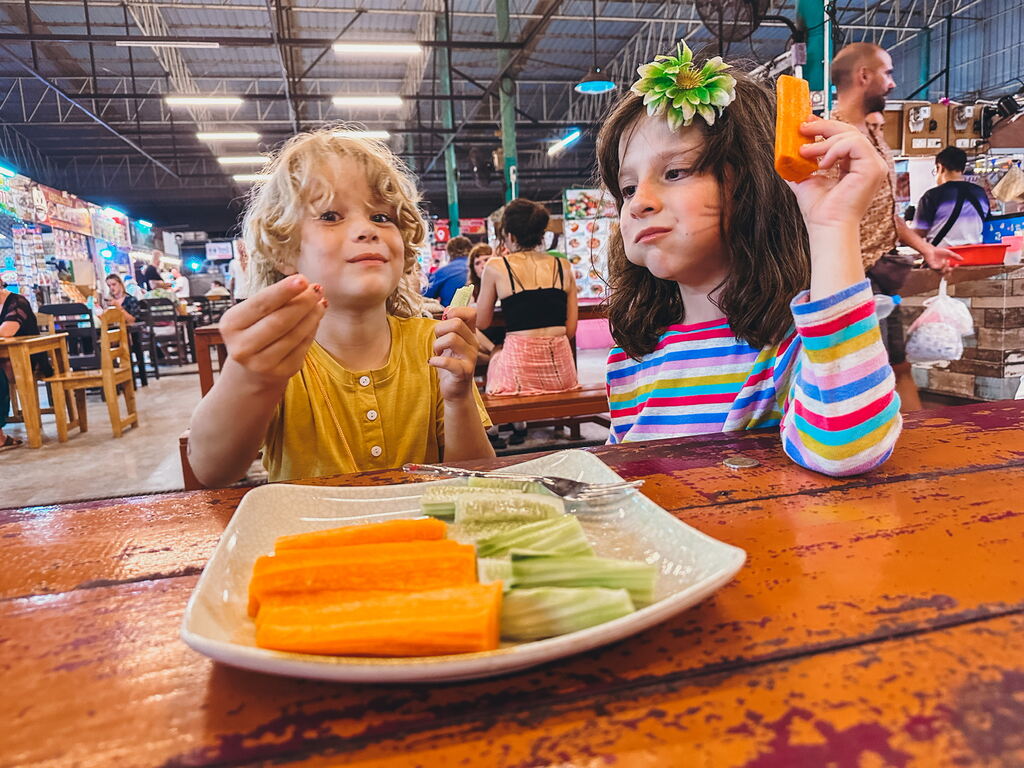
Indoor Dining vs. Outdoor Seating
Unfortunately, a large portion of the restaurants in Thailand are right next to busy roads. And, of course, they don’t have fences or anything like that. With an active toddler, I would definitely recommend sitting indoors. Our little one is so headstrong; it’s just happened too often that she simply runs off. It’s much more comfortable sitting indoors—where there’s also AC—and knowing that the door to the street is closed.
It’s different, of course, with beach restaurants or restaurants in quiet natural settings. There, I definitely recommend sitting outside, preferably as close as possible to where the little ones are playing. For example, on the beach in the front row, so you don’t have to squeeze through a bunch of other tables every time the child wants something.
Another advantage of sitting outside is that the mess the child is likely to leave under the high chair isn’t as noticeable.
👉 You might also find these articles interesting:
– The Most Important Vaccines for Thailand Travel
– Where to See Elephants in Thailand?
– When is the Cheapest Time to Fly to Thailand?
– The 8 Best Airlines to Fly to Thailand
– What to Wear in Thailand? 20 Do’s and Don’ts
Must-Try Kid-Friendly Dishes in Thailand
Here are some popular Thai dishes that are mild and usually loved by kids:
Pad Thai: A popular noodle dish made with stir-fried rice noodles, often served with a choice of protein.
Tofu or Chicken Satay: Grilled chicken or tofu skewers with a side of peanut sauce.
Thai Fried Rice: Rice stir-fried with eggs, veggies, and a choice of protein.
Mango Sticky Rice: The most popular Thai dessert made of rice, fresh mango, and a sweet coconut sauce, perfect for kids with a sweet tooth.
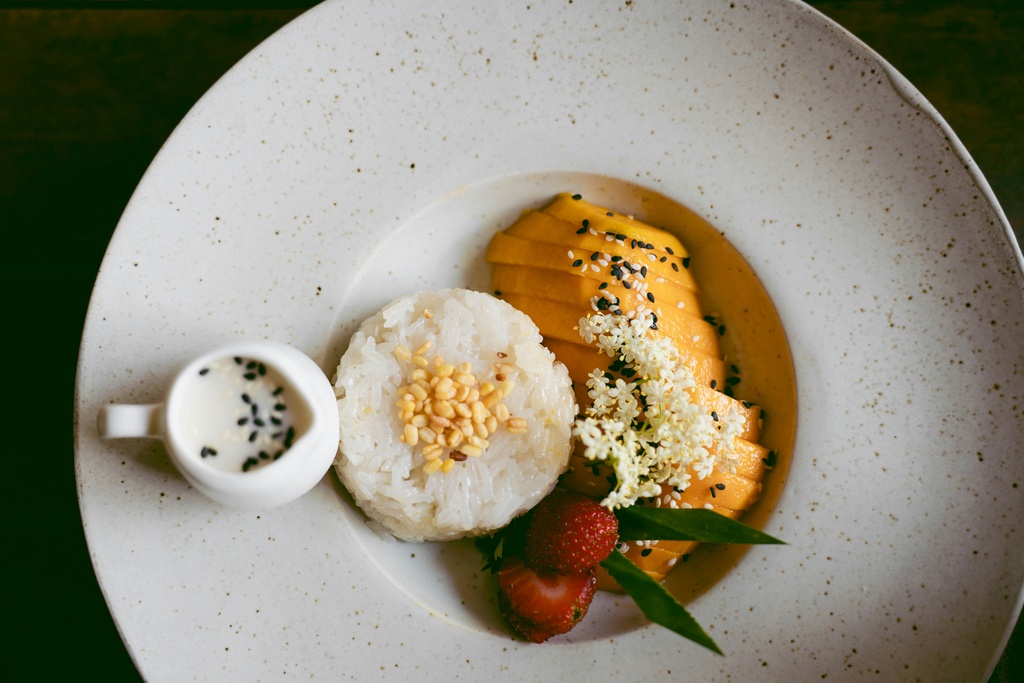
Dealing with Food Allergies and Dietary Restrictions
If your child has food allergies, don’t worry. Many Thai restaurants are accommodating. Learn some basic Thai phrases or use Google Translate to communicate dietary needs. Here are the most important phrases to address dietary restrictions. Please note that in Thai, women typically use “chan” for “I”, while men use “pom”.
No Spicy
Phrase: “Mai ao phet”
Meaning: “I don’t want it spicy.”
How to address:
- Mild: “Phet nit noi”
Meaning: “Just a little spicy.” - Without chili: “Mai sai prik”
Meaning: “Without chili.” - Not spicy at all: “Mai ao phet leoi”
Meaning: “Not spicy at all.”
Vegetarian
Phrase: “Chan/Pom gin mangsawírat”
Meaning: “I am a vegetarian.”
How to address:
- Without meat: “Mai sai néua sat”
- Without fish: “Mai sai bplaa”
- Without fish sauce: “Mai sai náam bplaa”
Vegan
Phrase: “Chan/Pom gin jay”
Meaning: “I am vegan.”
How to address:
- No eggs: “Mai sai khài”
- No milk: “Mai sai nom”
- No honey: “Mai sai náam pêueng”
Gluten-Free
Phrase: “Chan/Pom pháe gluten”
Meaning: “I am allergic to gluten.”
How to address:
- No soy sauce: “Mai sai si-íw”
- No wheat: “Mai sai khâo sălee”
Nut Allergy
Phrase: “Chan/Pom pháe thùa”
Meaning: “I am allergic to nuts.”
How to address:
- No peanuts: “Mai sai thùa-lí-sŏng”
- No cashews: “Mai sai mét má-mûang hima-pan”
Lactose Intolerance
Phrase: “Chan/Pom pháe nom”
Meaning: “I am lactose intolerant.”
How to address:
- No milk: “Mai sai nom”
- No cheese: “Mai sai chîit”
- No butter: “Mai sai nôei”
Shellfish Allergy
Phrase: “Chan/Pom pháe aa-hăan thá-lay”
Meaning: “I am allergic to shellfish.”
How to address:
- No shrimp: “Mai sai gûng”
- No crab: “Mai sai bpuu”
- No shellfish: “Mai sai hói”
Halal
Phrase: “Chan/Pom gin aa-hăan há-lăan”
Meaning: “I eat Halal food.”
How to address:
- Is this Halal? “An-níi há-lăan măi?”
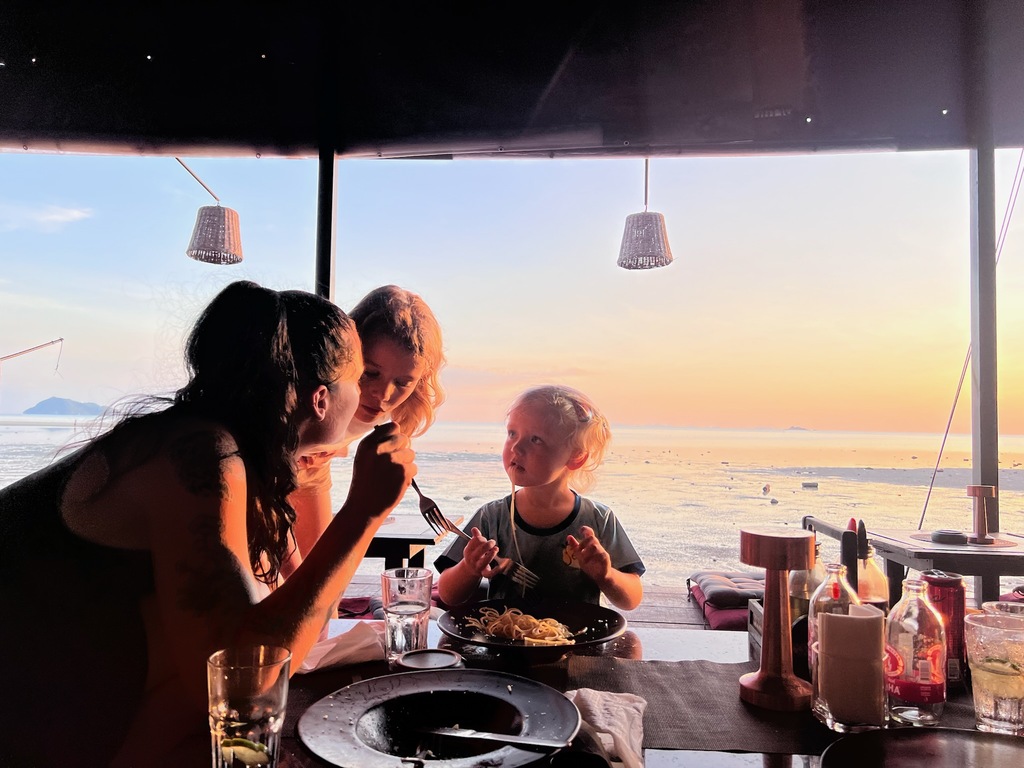
Final Thoughts on Eating Out with Kids in Thailand
Honestly, eating out with kids in Thailand isn’t as scary as it sounds. I think, like so many things in life, it all comes down to expectations. If you’re open and flexible, prepare well, and time your meals right, the chances are high that it’ll be a great experience! I wish your whole family lots of wonderful restaurant visits in Thailand with your little ones!
What have your experiences been like so far? Is there a favorite restaurant that you visited when eating out with kids in Thailand? Let me know in the comments!
Thanks for reading and for letting me be a part of your day. Yours, Lulu


